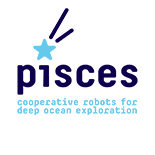

PISCES
About Us
The Center for Robotics and Autonomous Systems at INESC TEC aggregates researchers with a vast experience in the development, customization, and deployment of marine robotic solutions, for more than 20 years. During the last years, we have dedicated a large effort in increasing the autonomy of underwater robotics: diving to deep waters, developing smart behaviors for robotic systems, and pursuing solutions for long term presence in the ocean. The Shell Ocean Discovery XPRIZE presents challenges that are perfectly aligned with these long-term goals, and for which we have already dedicated a lot of effort. We are aware of the tremendous difficulties to overcome such challenges, particularly within the short time frame available, and the need for a groundbreaking solution. For us, this solution lies in cooperative robotics, with a constellation of state of the art pieces of technology, collaborating towards a common goal – the PISCES system. We set the example to our robots, by aggregating systems and researchers from multiple institutions. We are convinced that the PISCES approach will be a breakthrough in ocean exploration and discovery, not only to undertake the challenges of this competition, but also to extend the operation to even larger areas of the oceans.
TECH INFORMATION
The team is aggregating Portuguese technologies developed at INESC TEC (Porto) and CINTAL (Algarve) to create the PISCES system that leverages cooperative robotics. In fact, the main idea behind the PISCES system is the use of fully autonomous complementary marine robotic platforms. These will work in cooperation for deep water exploration:
• A deep water AUV – a 4000 meter rated underwater vehicle, with payload sensors for image and sonar mapping, and also an array of acoustic receivers for long range, large swath mapping.
• The Roaz ASV – a long range Autonomous Surface Vehicle for AUV launch and recovery, also working as acoustic sources for long range bathymetry during the survey.
• Zarco and Gama ASVs – smaller vehicles used to provide a constellation of acoustic transmitters for AUV navigation, ensuring a constant (bounded) accuracy of the AUV navigation system.
TEAM LEAD
Nuno Cruz holds a MSc. in Digital Systems Engineering from UMIST, UK, and a PhD. in Electrical Engineering from the University of Porto, in Portugal. He is currently an Assistant Professor at the Faculty of Engineering of the University of Porto and a Research Coordinator at the Centre for Robotics and Autonomous Systems at INESC TEC. He has been involved in the development and deployment of marine robotic vehicles for more than 20 years. He has led the design of multiple autonomous maritime vehicles at the University of Porto and INESC TEC, namely the Zarco and Gama ASVs and the MARES, TriMARES and DART AUVs. His current research interests include the development of strategies for the efficient use of autonomous vehicles at sea, including the concept of adaptive sampling.
TEAM MEMBERS
| Alexandra Nunes | Alfredo Martins |
| Ana Moreira | Ana Rita Gaspar |
| Andry Pinto | Aníbal Matos |
| António Silva | Ashley P. Hughes |
| Bruno Ferreira | Carlos Gonçalves |
| Eduardo Silva | Friedrich Zabel |
| Guilherme Amaral | Hugo Ferreira |
| Hugo Ferreira | José Miguel Almeida |
| José Carlos Alves | Luis Santos |
| Marcos Martins | Nuno Abreu |
| Nuno A. Cruz | Orlando C. Rodrı́guez |
| Pedro Margarido | Vítor Pinto |